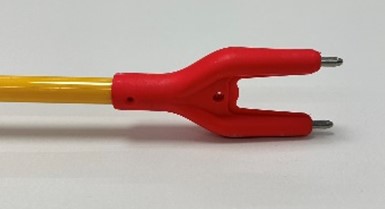Rakova spoke about the use of metropolitan neural networks by physicians of the Yamalo-Nenets Autonomous Okrug

 PIONEER MEIZHENG BIO-TECH (5 in1) JC0871/ Rapid tests for the determination of the residual amount of β-lactams, tetracyclines, chloramphenicol, streptomycins, ceftiofur in milk, whey.
PIONEER MEIZHENG BIO-TECH (5 in1) JC0871/ Rapid tests for the determination of the residual amount of β-lactams, tetracyclines, chloramphenicol, streptomycins, ceftiofur in milk, whey. Rapid tests for fluoroquinolone, erythromycin, lincomycin, tillosin and tilmycosin residues in milk, whey
Rapid tests for fluoroquinolone, erythromycin, lincomycin, tillosin and tilmycosin residues in milk, whey
As part of an experiment to introduce computer vision technologies into medicine using algorithms used by Moscow radiologists, more than 27 thousand studies of patients in the Yamalo-Nenets Autonomous District were analyzed, said Anastasia Rakova, Moscow Deputy Mayor for Social Development.
According to the vice-mayor, the Moscow HUB Telemed platform allows radiologists of the YNAO to work with seven artificial intelligence services in four areas of research: fluorography, radiography, as well as computed tomography of the chest organs and mammography. “The number of medical organizations that use neural networks to describe images in the region has increased to 14 in six months,” Rakova specified.
The possibilities of artificial intelligence available to metropolitan specialists have been used in the Yamalo-Nenets Autonomous Okrug for the analysis of radiological examinations of patients for six months already. During this time, about 80 radiologists in the region began to use algorithms that automate routine processes and save the doctor's time. Specialists of the Moscow Center for Diagnostics and Telemedicine of the Moscow Department of HEALTH accompany the process and control the quality of neural networks.
According to the DIRECTOR of the center Yuri Vasiliev, Moscow is ready to share its experience and is open to cooperation with other regions of the country. “Our specialists carry out daily scientific and analytical work on the selection, testing, and implementation of the best developments,” Vasilyev emphasized. “The use of computer vision in medicine reduces the time spent on diagnostic procedures, and also provides doctors with the information to make accurate diagnoses.”
Today, artificial intelligence helps to find signs of diseases in 20 areas, and the number of X-ray studies processed with its help has already exceeded 9 million. About 150 medical organizations and 20 it companies — developers and providers of artificial intelligence services — are participating in the experiment.
Neural networks help to find signs of lung cancer, covid-19 , spinal osteoporosis, aortic aneurysm, coronary heart disease, stroke, pulmonary hypertension, hydrothorax, as well as breast cancer, spinal hernias, flat feet and other diseases in radiological images .
Read together with it:
- Чего ожидать от «одной из самых рискованных» поездок ТрампаДональд Трамп начал турне по Азии, в ходе которого встретится с лидерами ключевых стран, включая Си Цзиньпина. Почему эта поездка может оказаться сложнее, чем недавние визиты в Европу и на Ближний Восток — в статье РБК Дональд Трамп Какие встречи запланированы в ходе турне Президент США Дональд Трамп вылетел из Вашингтона поздним вечером в пятницу, 24 октября, и утром в субботу его борт приземлитс...
- Callas spoke about the EU's joy over new US sanctions against Russia.The European Union welcomes the US "signals" regarding RUSSIA, Kallas said. She called Washington's new sanctions against Rosneft and LUKOIL a "signal of strength" and agreement between Europe and the US. Moscow considers the sanctions illegal.The European Union approves the US imposition of new sanctions against Russia, European Union Foreign Minister Kaja Kallas told reporters. Kallas published ...
- Матричные РНК-вакцины от COVID продлили жизнь тяжелых раковых больныхМатричные РНК-вакцины против коронавируса продлили жизнь пациентам, больным раком в самой тяжелой, четвертой стадии, сообщает The Washington Post. К такому выводу пришли исследователи Онкологического центра имени М. Д. Андерсона Техасского университета и Университета Флориды. «Эти данные невероятно интересны, но они должны быть подтверждены в ходе третьего этапа клинических испытаний», — заявил од...
- Politico learned of a split in the EU over a new €140 billion loan to Ukraine.European countries have still not agreed on the terms of a €140 billion loan to Kyiv to cover the Ukrainian budget deficit and purchase weapons, Politico reports. As the publication notes, France , Italy , and Germany insist that Kyiv use the loan to purchase weapons from European, not American, contractors. The idea was first put forward by German Chancellor Friedrich Merz in an article for the F...
- The Russian Union of Travel Industry (RUTI) clarified that EU sanctions will not affect Russian tourism.New EU sanctions prohibit European travel companies from organizing trips to RUSSIA for their citizens. This will not affect the operations of Russian tour operators, Georgy Mokhov, Vice President of the Russian Union of Travel Industry, told RBC, commenting on the 19th package of EU sanctions against Moscow. "This measure does not affect the activities of Russian tour operators within the country...
- AvtoVAZ and Polyus were included in the 19th package of EU sanctions against Russia.The 19th sanctions package against RUSSIA includes the parent company of the FESCO Group, AvtoVAZ, Polyus, and Evraz. The Zvezda shipbuilding complex was also subject to restrictive measures.As part of the 19th sanctions package against Russia, the European Union has imposed restrictive measures against Russian automakers AvtoVAZ and Sollers. The corresponding document was published in the Europea...
- Jobs, Musk, Bezos: How Business Gurus Make Meetings Less ExhaustingSteve Jobs once refused to attend a meeting with the US President because the attendee list was too long. Anna Yoshitsugu, Senior Strategy and Development Manager at Uber, explains how business gurus prevent meetings from "stealing" their time.Let's say you hold one meeting each week, it lasts two hours, and there are ten people in attendance, each with an average salary of 1......
- "Ambitious plans." Brest Regional Executive Committee on the region's contribution to food security in the Union State.October 23, Brest. Brest Oblast is constantly expanding capacity to increase food production. This information was announced by Deputy Chairman of the Brest Oblast Executive Committee, Mikhail Batsenko, during a press tour dedicated to ensuring food security in the Union State, a BELTA correspondent reports. "Our level of self-sufficiency in basic agricultural products across all types exceeds 1.....


























































